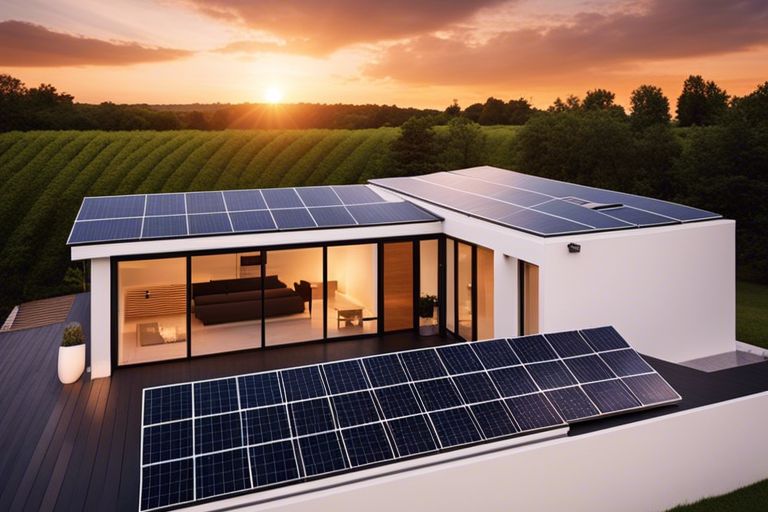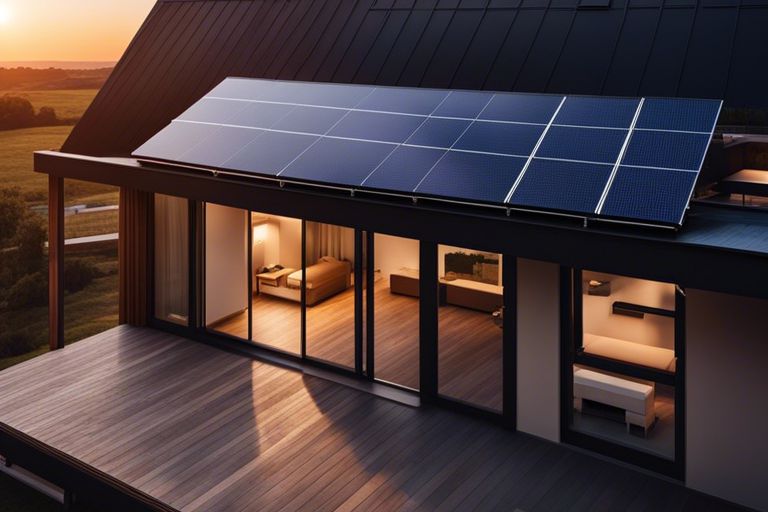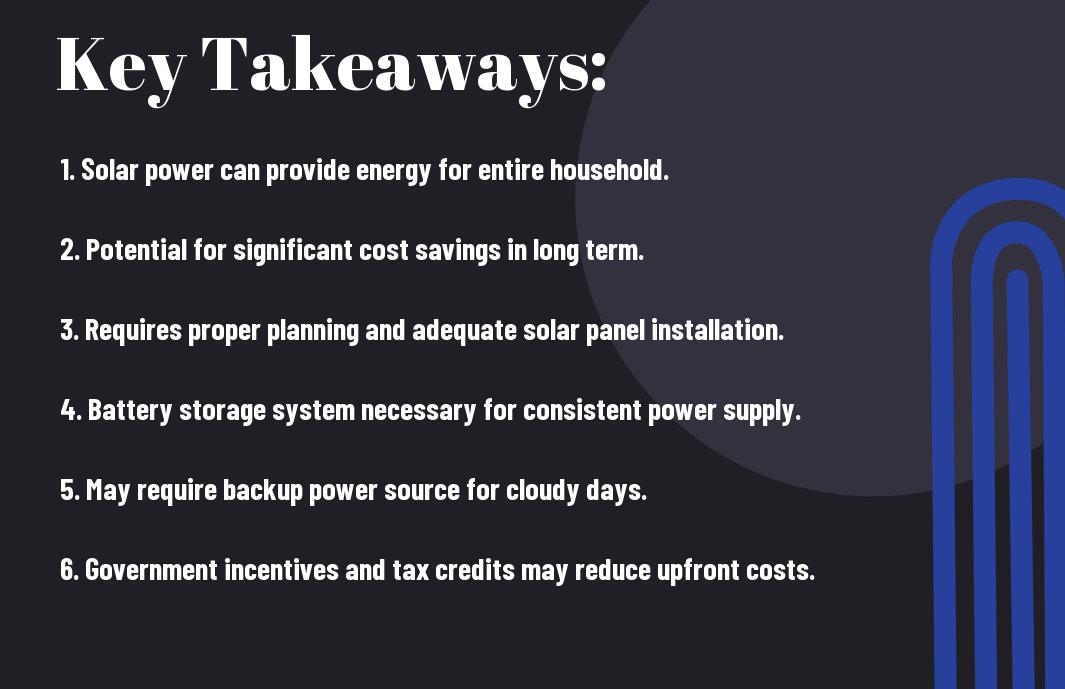There’s a growing curiosity about whether it is feasible to power an entire household solely on solar energy. You may be pondering the same question, intrigued by the prospect of harnessing the power of the sun to meet your daily energy needs. In this article, we will research into the possibilities and considerations of running a whole house on solar power, exploring the potential benefits and challenges that come with this eco-friendly energy solution.
Key Takeaways:
- Solar panels: Installing a sufficient amount of solar panels on your roof can generate enough electricity to power your whole house.
- Battery storage: Investing in a battery storage system allows you to store excess energy generated during the day for use at night or during cloudy days.
- Energy-efficient appliances: Using energy-efficient appliances can help reduce overall energy consumption and make it easier to run a whole house on solar power.
- Net metering: Taking advantage of net metering allows you to sell excess energy back to the grid, helping to offset your electricity costs.
- Professional consultation: Consulting with a professional solar installer can help you determine the feasibility of running your whole house on solar power and create a customized plan for your specific needs.
The Basics of Solar Power
Before entering into whether it is possible to run your whole house on solar power, it’s crucial to understand the basics of how solar power works. Solar power is harnessed by using photovoltaic cells to convert sunlight into electricity. These cells are typically made of silicon and work by creating an electric field when exposed to sunlight. When sunlight hits the cells, it knocks electrons loose from their atoms, allowing them to flow and create electricity.
How Solar Panels Work
Basics of how solar panels work can be understood by looking at the process of converting sunlight into electricity. Solar panels consist of photovoltaic cells that absorb sunlight and convert it into direct current (DC) electricity. This electricity then flows into an inverter, which converts it into alternating current (AC) electricity that can be used to power your home. The excess electricity generated can be stored in batteries for later use or fed back into the grid.
Types of Solar Panels
On the market, there are two main types of solar panels: monocrystalline and polycrystalline. Monocrystalline panels are made from single-crystal silicon and are known for their efficiency and sleek design. Polycrystalline panels, on the other hand, are made from multiple silicon crystals and are more affordable but slightly less efficient. In terms of aesthetics, monocrystalline panels are often considered more visually appealing for residential installations.
| Monocrystalline Panels | Polycrystalline Panels |
| Higher efficiency | Lower efficiency |
| More expensive | Less expensive |
| Sleeker design | Slightly bulkier |
| Longer lifespan | Shorter lifespan |
This breakdown should help you understand the differences between monocrystalline and polycrystalline panels when considering options for running your whole house on solar power. Assume that the choice you make will depend on your budget, space available for installation, and desired efficiency. Importantly, both types of panels can effectively power your home using clean, renewable solar energy.

Assessing Your Energy Needs
Clearly, before considering running your whole house on solar power, you need to assess your energy needs. This involves calculating your energy consumption and identifying energy-intensive appliances.
Calculating Your Energy Consumption
For calculating your energy consumption, you can start by looking at your past electricity bills. They will give you an idea of how many kilowatt-hours (kWh) you use on average per month. By analyzing this data, you can estimate the daily kWh your household consumes and use that to determine the number of solar panels needed to meet your energy requirements.
Identifying Energy-Intensive Appliances
Any appliances that consume a significant amount of energy should be identified when assessing your energy needs. Examples of energy-intensive appliances include air conditioners, electric water heaters, and clothes dryers. These devices can significantly impact the size of the solar power system you will need.
This step is crucial because replacing or minimizing the usage of energy-intensive appliances can help you lower your overall energy consumption and make it easier to run your house on solar power.

Sizing Your Solar Panel System
Determining the Required System Size
Unlike conventional power sources, solar power relies on the capacity of your solar panel system to generate and store electricity for use when the sun is not shining. To determine the required system size for your whole house, you need to consider your energy consumption patterns, the peak sunlight hours in your location, and the system’s efficiency.
Factors Affecting System Efficiency
Sizing your solar panel system involves understanding the various factors that can affect its efficiency. These factors include the angle and orientation of your panels, shading from nearby trees or buildings, temperature, and the quality of the solar panels and inverters you choose. This
- means that positioning your panels to receive maximum sunlight exposure throughout the day is crucial for optimal efficiency.
To further optimize your system’s efficiency, you should also consider investing in high-quality solar panels and inverters. This
- will ensure that your system can convert the maximum amount of sunlight into usable electricity for your home.
Overcoming Energy Storage Challenges
Many people wonder how many solar panels they need to power their homes. If you’re also curious about this, you can check out this Wondering How Many Solar Panels You Need? Here’s a… guide for more information.
The Role of Batteries in Solar Power Systems
With the advancements in solar energy technology, the role of batteries in solar power systems has become increasingly important. Batteries allow you to store excess energy generated during the day for use during the night or on cloudy days. This way, you can ensure a constant and reliable power supply for your home, reducing your dependence on the grid.
Advances in Energy Storage Technology
For a long time, one of the main challenges of solar power systems has been energy storage. However, recent advances in energy storage technology have addressed many of these issues. New battery technologies, such as lithium-ion batteries, are more efficient, durable, and cost-effective than ever before. These advancements have made it easier for homeowners to store and use solar energy whenever they need it.
Overcoming energy storage challenges is important for running a whole house on solar power. By utilizing the latest battery technologies and understanding how many solar panels you need for your home, you can create a sustainable and reliable energy system that meets your household’s needs.
Integrating Solar Power into Your Home
Grid-Tied Systems vs. Off-Grid Systems
GridTied After deciding to integrate solar power into your home, you will need to choose between a grid-tied system and an off-grid system. A grid-tied system allows you to remain connected to the utility grid, providing you with the flexibility to use electricity from the grid when needed and sell excess energy back to the grid. On the other hand, an off-grid system operates independently from the utility grid, requiring battery storage to store excess energy for use when the sun is not shining.
Installation and Maintenance Considerations
The installation of solar panels on your roof or property requires careful planning to ensure optimal sunlight exposure and energy production. The maintenance of a solar power system is relatively low, with occasional cleaning and inspection required to ensure everything is functioning properly. The financial benefits of solar power often outweigh the costs of installation and maintenance in the long run, making it a worthwhile investment for your home.
Another important consideration is the lifespan of your solar power system. Most solar panels come with a warranty of 25 years or more, ensuring that you will benefit from clean and renewable energy for many years to come. Additionally, advancements in technology continue to improve the efficiency and durability of solar panels, making them an even more attractive option for homeowners looking to reduce their carbon footprint and energy bills.
Economic and Environmental Benefits
Cost Savings and Incentives
Economic advantages of running your whole house on solar power can be substantial. By harnessing the power of the sun, you can significantly reduce or even eliminate your electric bill. In addition, many governments and local authorities offer incentives, such as tax credits or rebates, to encourage homeowners to switch to solar energy. These incentives can help offset the initial cost of installing solar panels.
Reducing Your Carbon Footprint
Your choice to power your home with solar energy not only benefits your wallet but also the environment. Solar power is a clean and renewable energy source that produces no greenhouse gas emissions, unlike traditional fossil fuels. By reducing your reliance on fossil fuels and switching to solar power, you are taking a significant step towards reducing your carbon footprint and minimizing your impact on the planet.
Reducing your carbon footprint through solar power can lead to a healthier environment for future generations. By embracing sustainable practices like solar energy, you are contributing to a cleaner and greener planet for your children and grandchildren to enjoy. Your decision to go solar not only benefits you financially but also plays a vital role in preserving the Earth’s natural resources for the future.
Environmental

To wrap up
Following this informative journey on the possibility of running a whole house on solar power, you have learned about the advancements in solar technology, the factors to consider when determining if your house can run on solar power, and the potential benefits of making the switch to solar energy. While it may be challenging to completely run a whole house solely on solar power, with the right system size, energy-efficient appliances, and battery storage, it is certainly a possibility.
So, if you are considering making the transition to solar power for your home, remember that each household’s energy needs are unique, and it’s important to carefully evaluate your situation and consult with professionals to determine the most effective solar solution for you. Embracing solar power not only offers environmental benefits but can also lead to long-term energy savings and increased energy independence for you and your household. The future of solar energy is bright, and with the right approach, running a whole house on solar power can be a realistic and sustainable choice.
Q: Can a whole house be powered solely by solar power?
A: Yes, it is possible to power an entire house using solar power. By installing a sufficient number of solar panels on the roof or in the yard, a house can generate enough electricity to meet its needs.
Q: What are the key components needed to power a whole house with solar energy?
A: The key components required to power a whole house with solar energy include solar panels, an inverter to convert the DC electricity generated by the panels into AC electricity usable in the home, a battery storage system to store excess energy for use at night or on cloudy days, and a connection to the grid for times when solar energy production is low.
Q: Is it cost-effective to run a whole house on solar power?
A: The cost-effectiveness of running a whole house on solar power depends on various factors such as location, energy consumption, available incentives, and the cost of electricity from the grid. In many cases, solar power can lead to long-term cost savings, especially as the price of solar technology continues to decrease and electricity rates rise.
Can you sell power back to the grid in Oregon
